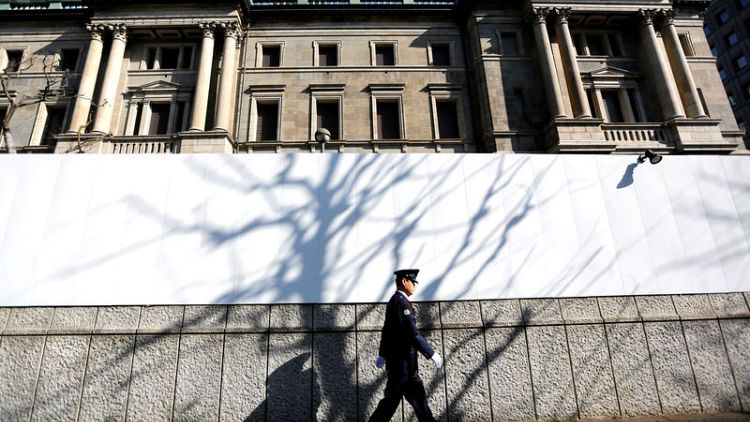By Leika Kihara
TOKYO (Reuters) - Some Bank of Japan policymakers voiced strong concern over risks to the economic outlook and called for discussion on ways to ramp up stimulus, a summary of their opinions at a July rate review showed on Wednesday.
Others, however, advised against immediate stimulus due to the strain prolonged easing was inflicting on financial institutions, highlighting the rift in the nine-member board between those who favour more action and those against it.
At the July meeting, BOJ policymakers debated heightening overseas risks that one member said could tip Japan into recession.
"The BOJ must communicate more clearly its resolve to take additional monetary easing steps without hesitation if the momentum to achieve its price target is under threat," one of the members was quoted as saying.
"We must also consider in advance what steps we can take if we were to ease," the member added.
Several other opinions showed support for pre-emptive monetary easing to forestall risks. One said the BOJ must use both its interest rate targets and forward guidance to ease policy further, without elaborating, according to the summary.
"We need to assess the benefits and demerits of various monetary easing steps," one member said, a sign that the central bank has a range of easing options it could consider.
At the July meeting, the BOJ kept monetary policy steady but said it would ease without hesitation to pre-empt risks that could hurt the chance of achieving its 2% price goal.
The escalating U.S.-China trade war has jolted markets and triggered an unwelcome yen spike, piling pressure the BOJ to ramp up stimulus to support an export-reliant economic recovery.
But with interest rates hovering around zero, the BOJ is left with little ammunition to fight the next recession. Prolonged ultra-low rates have also heightened the cost of additional easing by hurting financial institutions' margin.
One board member said the BOJ must be cautious about topping up stimulus, and ensure its measures do not destabilise Japan's banking system, the summary showed.
"If overseas economies worsen further and hurt Japan's economy and prices, we must act swiftly with a mix of fiscal and monetary policies," another member said.
"But it's important to maintain the current stimulus policy for the time being with an eye on the side-effects to Japan's financial system."
Under a policy dubbed yield curve control (YCC), the BOJ guides short-term rates at -0.1% and 10-year government bond yields around 0%.
It also has in place forward guidance, or a pledge on future monetary policy moves, that promises to keep rates at current ultra-low levels at least until around the spring of next year.
(Reporting by Leika Kihara; Editing by Chris Gallagher and Sam Holmes)



